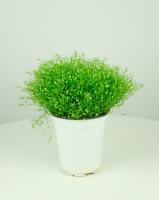How to Care for a Peperomia Plant
If you're looking for a low-maintenance houseplant that still adds character and charm to your home decor, consider a peperomia plant. These plants are known for their vibrant foliage and compact size, making them perfect for small spaces and beginner plant parents. Here are some tips for how to care for a peperomia plant.
Light
Peperomia plants prefer bright, indirect light. They can also tolerate low light, but their growth may slow down. Avoid placing them in direct sunlight, as this can scorch their leaves. If the leaves start to look pale or turn yellow, it may be a sign that they're getting too much direct light.
Water
Peperomias should be watered when the top inch of soil feels dry to the touch. They don't like to sit in wet soil, so make sure their pot has good drainage. Overwatering can cause the roots to rot, so it's better to err on the side of underwatering. Water them less frequently in the winter months when they're not actively growing.
Humidity
Peperomias thrive in humid environments, but they can still do well in lower humidity levels. You can increase humidity by placing a tray of water near the plant or using a humidifier. If the air is too dry, the leaves may start to curl or brown at the tips.
Temperature
Peperomias prefer temperatures between 60-75掳F (15-24掳C). They can tolerate cooler temperatures, but avoid placing them near drafty windows or doors. If the temperature drops below 50掳F (10掳C), the plant may start to suffer.
Fertilizer
Peperomias don't need a lot of fertilizer. You can feed them once a month during the spring and summer months with a balanced liquid fertilizer. Avoid fertilizing in the winter when they're not actively growing.
Pruning
Peperomias don't require much pruning, but you can pinch back the stems to encourage bushier growth. You can also remove any yellow or dead leaves to keep the plant looking its best.
Pests and Diseases
Peperomias are generally pest and disease-resistant, but they can still be affected by mealybugs, spider mites, and fungal infections. If you suspect your plant has pests or disease, isolate it from other plants and treat it with an appropriate insecticide or fungicide.
In conclusion, caring for a peperomia plant is relatively easy as long as you provide it with the right growing conditions. With a little bit of attention and care, your peperomia plant can thrive and add a touch of greenery to your home.

 how many times do yo...
how many times do yo... how many planted tre...
how many planted tre... how many pine trees ...
how many pine trees ... how many pecan trees...
how many pecan trees... how many plants comp...
how many plants comp... how many plants can ...
how many plants can ... how many plants and ...
how many plants and ... how many pepper plan...
how many pepper plan...
































